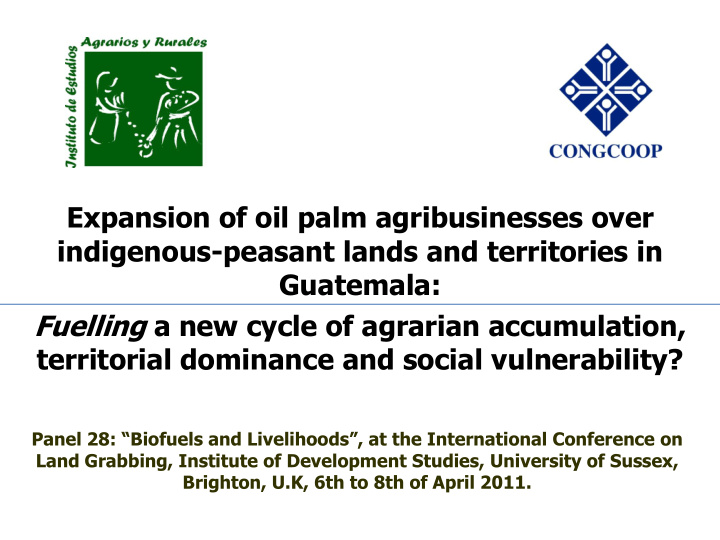



Expansion of oil palm agribusinesses over indigenous-peasant lands and territories in Guatemala: Fuelling a new cycle of agrarian accumulation, territorial dominance and social vulnerability? Panel 28: “Biofuels and Livelihoods”, at the International Conference on Land Grabbing, Institute of Development Studies, University of Sussex, Brighton, U.K, 6th to 8th of April 2011.
Figure 1: Maps illustrating administrative and ethnic territorial settlement. The circumference demarcates the research setting coincident with lands at 500 m.a.s.l
Level n+1 (socio and agro-ecological area) Level n (Village) Level n-1 (Houseolds) Level n-2 (Gender divided subjects)
Figure 2: Evolution of palm oil produced ( thousands of tons ) and oil palm harvested land in Guatemala and Central America 3 ( thousands of ha ). Year 2000 to 2010. 450 400 350 300 250 200 150 100 50 0 2000 2005 2010 Oil palm harvested land in Guatemala Oil palm harvested land in Central America Palm oil production in Guatemala Source: IDEAR with data from the Guatemal´s Oil Pallm Guild, CEPALSTAT & BANGUAT
Figure 3: Land harvested with maize, oil palm, sugarcane & jatropha. 2010 Conditions: CLIMATE Temperature ºC Rainfalls mm ALTITUTE Elevation m.a.s.l Hill in % SOILS Effective depth Drainage Texture pH Populated areas, national parks, protected areas and forests are excluded Maize 18,937 km2 Oil palm 7,921 km2 Sugarcane 3,759 km2 Jatropha 2,061 km2
Figure 3: Land use in the year 2000 in areas harvested with oil palm in 2010 Forest & wetlands (49%) 14% 8% Food crop lands (29%) 49% Export crop lands (8%) 29% Cattle lands (14%) Source: IDEAR & the Government of Guatemala´s National Council of Protected Areas
Water intake pie and palm oil mills waste drainages to La Pasión river, Sayaxche, Petén. IDEAR 2010. Contaminated water from oil palm plantations and palm oil mills towards La Pasión river, Sayaxche, Petén. IDEAR 2010.
Communal-customary institutions for the management of land and common pool resources
Figure 4: Opinion when asked: is an oil palm plantation like a forest? 100% 80% 60% 40% 20% 0% Men with palm Men working for Men not working Women whose Women whose job OPA for OPA spouse works for spouse does not OPA work for OPA Yes No
Figure 5: Opinion when asked: Did family and/or community living conditions change when the oil palm agribusinesses arrived? How? 80% 70% 60% 50% 40% 30% 20% 10% 0% Men working for Men not working for Women whose Women whose OPA OPA spouse works for spouse does not OPA work for OPA Family improved Family worsened Family no changes Village improved Village worsened Village no changes
Figure 6: Conflicts registered by the Guatemalan Government. Year 2011 Main conservation enclosures and expansion territories of mining & oil companies and oil palm agribusinesses Source: Compiled by author. The different dot colors refer to the kinds of conflict.
Figure 7: Gross Territorial Product according to crop systems in the Polochic areas in 2008 (in Quetzales 1US$= 8GTQ).
Figure 8: Employment generated (in workdays per ha) at territorial and national levels by crop systems in the Polochic areas. 2008
Figure 9: Average time use by men and women during the plowing season in Polochic Valley & Hill villages (hours in a day). Women Men 24 22 20 18 Agriculture & 16 livestock tasks 14 Social events 12 Household tasks Sleeping 10 Personal care 8 6 4 2 0 Polochic Valley Polochic Hill I Polochic Hill II Polochic Hill I Polochic Hill II Polochi Valley
“Illegal” maize THANK YOU planting in a new oil palm plantation .
Recommend
More recommend